Click on images to enlarge

dense infestation (Photo: Sheldon Navie)
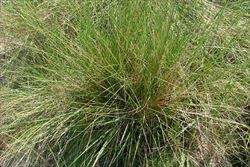
tussock-forming habit (Photo: Sheldon Navie)
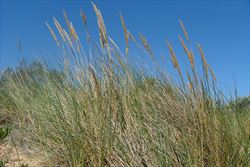
habit in flower (Photo: Sheldon Navie)

habit in flower (Photo: Sheldon Navie)
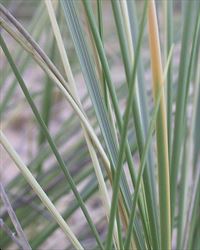
close-up of leaves, the older ones are strongly rolled inwards (Photo: Jackie Miles and Max Campbell)
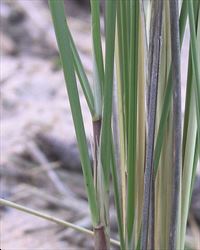
close-up of the stems and leaf blade bases, showing the large membranous ligules (Photo: Jackie Miles and Max Campbell)
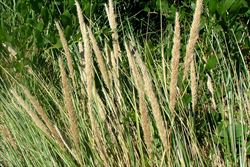
the spike-like seed-heads (Photo: Sheldon Navie)
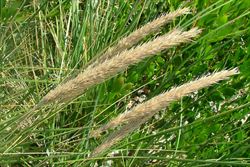
mature seed-heads (Photo: Sheldon Navie)
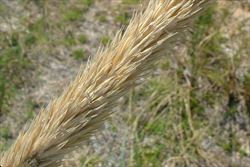
close-up of the numerous, densely arranged, flower spikelets (Photo: Sheldon Navie)

close-up of seeds (Photo: Steve Hurst at USDA PLANTS Database)
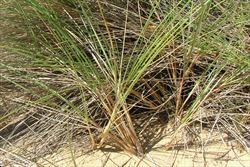
younger plants, which have originated from the creeping underground stems (Photo: Sheldon Navie)
Scientific Name
Ammophila arenaria (L.) Link
Synonyms
Arundo arenaria L.Ammophila arundinacea Host
Family
Gramineae (South Australia)Poaceae (Queensland, New South Wales, the ACT, Victoria, Tasmania, Western Australia and the Northern Territory)
Common Names
beach grass, marram grass, European beach grass, European beachgrass, European marram grass, sea reed
Origin
Native to northern Africa, Europe and western Asia.
Cultivation
Marram grass (Ammophila arenaria) has been deliberately and widely cultivated on beaches in southern Australia as a sand stabiliser.
Naturalised Distribution
Widely naturalised in the coastal districts of southern Australia. It is common and widespread in the coastal areas of Victoria, Tasmania, south-eastern South Australia and south-western Western Australia. Less common or scattered in the coastal districts of New South Wales and is other parts of southern Western Australia and and southern South Australia. Also naturalised on Norfolk Island.
Naturalised overseas in southern Africa, New Zealand, western USA (i.e. California, Oregon and Washington) and Hawaii.
Habitat
A weed of beaches, dry coastal vegetation and sand dunes in the temperate regions of Australia. It is usually found within 1 km of the sea.
Habit
A long-lived (i.e. perennial) grass growing 0.5-1.2 m tall. It forms dense tussocky tufts and also spreads via creeping underground stems (i.e. rhizomes).
Distinguishing Features
-
a long-lived grass forming dense tussocks and growing 0.5-1.2 m tall.
-
it spreads quickly via creeping underground stems and produces seed-heads at the top of stiff upright stems.
-
its greyish-green leaves are mostly clustered towards the base of the stems and are usually tightly inrolled.
-
at the base of each leaf blade there is an elongated membranous structure 10-30 mm long.
-
its spike-like seed-heads (7-30 cm long and 1-3 cm wide) turn from green to straw-coloured as they mature.
Stems and Leaves
The upright (i.e. erect) stems are rigid, unbranched and hairless (i.e. hairless). They are smooth and usually only have a few joints (i.e. nodes).
The leaves consist of a leaf sheath the encloses the stem and a rigid and spreading leaf blade. Most of the leaves are arranged towards the base of the stems with their sheaths overlapping. The very elongated (i.e. linear) leaf blades are greyish-green in colour and come to a sharp point at the tip (i.e. acute apex). These leaf blades (20-70 cm long and 1-2.5 mm wide) are usually tightly inrolled (i.e. involute), but may be up to 6 mm wide when flattened. Their upper surfaces are hairy (i.e. pubescent), while their undersides and hairless (i.e. glabrous). Where the leaf sheath meets the leaf blade there is a relatively large elongated membranous structure (i.e. ligule) 10-30 mm long, which is often partially split in two.
Flowers and Fruit
The spike-like seed-heads (i.e. inflorescences) are borne at the tips of the stems and consist of several branches that are held closely to the stem (i.e. they are spiciform panicles). These seed-heads (7-30 cm long and 1-3 cm wide) are relatively long and narrow (i.e. narrowly-oblong to lanceolate-oblong) and contain numerous densely arranged flower spikelets (10-18 mm long). The individual flower spikelets are elongated in shape (i.e. narrowly-oblong) and brone on stalks (i.e. pedicels) 1-4 mm long. They consist of a pair of bracts (i.e. glumes) and a single tiny flower (i.e. floret). The floret has two floral bracts (i.e. a lemma and palea), three stamens (4-7 mm long) and an ovary topped with a feathery two-branched stigma. Flowering occurs mainly during spring and early summer (i.e. from October to February).
The seed-heads turn from green to straw-coloured or pale brown as they mature. The flower spikelets break apart at maturity, with the bracts (i.e. glumes) remaining on the seed-head and the floret being dispersed. The 'seeds' (i.e. grains or caryopses), when present, are egg-shaped (i.e. obovoid).
Reproduction and Dispersal
This species reproduces mainly by an extensive network of creeping underground stems (i.e. rhizomes), which can spread both vertically and horizontally. It can also produce seed, but these are often sterile.
The seeds may be spread by wind, water and animals. Segments of its underground stems (i.e. rhizomes) and seeds may also be dispersed in contaminated sand.
Environmental Impact
Marram grass (Ammophila arenaria) is a regarded as a significant environmental weed in Victoria and as a moderately important environmental weed in South Australia, Western Australia, Tasmania and New South Wales. It has been extensively planted as a sand binder on coastal sand dunes in the southern parts of Australia, but has spread from these plantings and is replacing native sand dune species. In areas where it has established of its own accord, or where conservation values are being degraded, it is considered a weed. However, it is still sometimes regarded as a useful plant where it is successfully employed as a sand stabiliser.
This species not only replaces native species, it also interferes with the natural dynamics of dune ecosystems. Coastal processes can be radically and permanently altered by the presence of this species. For example, marram grass (Ammophila arenaria) tussocks are more successful at trapping wind-blown sand than the native plants that it replaces, causing greater dune building around plants. This results in large steep-faced dunes being created, in contrast to the lower-angled foredunes that are associated with native vegetation.
This species has been described as by far the most widespread and compelling threat to native coastal vegetation in Tasmania. Native sand-binding grasses (e.g. Spinifex sericeus and Austrofestuca littoralis) do not compete well against the rapid growth rate and sand accumulation capability of marram grass (Ammophila arenaria). In northern and eastern Tasmania, some beaches are dominated by marram grass (Ammophila arenaria) and many others have small infestations. It is particularly common along the south-east coast of Tasmania and has been recorded in conservation areas in this region (i.e. in Tasman National Park) and elsewhere (i.e. in Greens Beach/Kelso Coastal Reserve in northern Tasmania).
During a recent study, it was found that two native beach-grass communities and five other coastal dune-plant communities in Tasmania are being replaced by marram grass (Ammophila arenaria), and it is thought that native sand-binding plant communities will steadily decline if no action is taken to protect them from invasion by this species. Native beach plants that are most commonly replaced include beach spinifex (Spinifex sericeus), beach fescue (Austrofestuca littoralis), dune sedge (Carex pumila) and glistening saltbush (Atriplex billardierei). This invasive species is also seen as a threat to the only known population of coast New Holland daisy (Vittadinia australasica var. oricola) in Tasmania. This species, which is common on the mainland but endangered in Tasmania, is under threat from loss of habitat through invasion of marram grass (Ammophila arenaria).
Native animals are also likely to be affected, as their habitat is transformed. Many shore birds, such as the endangered hooded plover (Thinornis rubricollis), prefer open beach sands and spits for nesting sites. These sites are frequently overgrown by marram grass (Ammophila arenaria) and it is possible that this process is contributing to the decline in hooded plover numbers in Tasmania.
In South Australia, marram grass (Ammophila arenaria) is listed as a common environmental weed of the Adelaide region and as a common coastal weed in the wider Gulf St. Vincent area. It has also been recorded in several coastal conservation areas in this state (e.g. Henley South and West Beach Dune Reserve, Aldinga Scrub Conservation Park and Coorong National Park). In New South Wales it is found south from Lake Macquarie, on the central coast, but is mostly a problem along the south coast.
In Victoria, marram grass (Ammophila arenaria) is listed as a high impact weed species in coastal dune scrub vegetation, appears on some local environmental weed lists (e.g. in Moyne Shire) and has been recorded in conservation areas (e.g. Phillip Island Nature Park). In Western Australia it has mainly become naturalised between Perth and Bremer Bay, but is listed among the top ten coastal weeds in the Central West Coast (i.e. from Shark Bay to Cape Naturaliste) and South-West Capes (i.e. Cape Naturaliste to Albany) regions of this state.
Coastal sand dune systems in other parts of the world are also being threatened by the establishment of marram grass (Ammophila arenaria). The impact of this species on the dune systems of South Africa is said to be considerable. Marram grass (Ammophila arenaria) also threatens sand dune communities on the eastern and western coasts of the USA. It displaces native dune species and significantly alters the morphology of dune systems in this country too. In fact, this invasive pant is said to exert more control over community competition than any other beach species. Research in California has shown that dense stands of marram grass (Ammophila arenaria) are excluding many native plants and animals, including many rare species. For example, the population size and diversity of sand-burrowing arthropods were found to decrease as marram grass (Ammophila arenaria ) cover increased.
Legislation
This species is not declared or considered noxious by any state or territory government in Australia.
Management
For information on the management of this species see the following resources:
- the Tasmanian Parks and Wildlife Service fact sheet on this species, which is available online at http://www.parks.tas.gov.au.
- the Tasmanian Beach Weed Strategy, which is available online at http://www.dpiw.tas.gov.au.
Similar Species
Marram grass (Ammophila arenaria) can be easily confused with several native look-alikes that also grow on sand dunes, including beach fescue (Austrofestuca littoralis), beach poa (Poa poiformis) and beach speargrass (Austrostipa stipoides). These species can be distinguished by the following differences:
- marram grass (Ammophila arenaria) leaves have a large membranous structure (i.e. ligule), 10-30 mm long, where the leaf sheaths meet the leaf blades. Its seed-heads are relatively large (7-30 cm long) and its flower spikelets only have a single tiny flower (i.e. floret). These flower spikelets do not have any obvious awns.
- beach fescue (Austrofestuca littoralis) leaves have a tiny membranous structure (i.e. ligule), 1-2 mm long, where the leaf sheaths meet the leaf blades. It seed-heads are relatively small (6-12 cm long) and its flower spikelets have 3-5 tiny flowers (i.e. florets). These flower spikelets do not have any obvious awns.
- beach poa (Poa poiformis) leaves have a tiny membranous structure (i.e. ligule), less than 1.5 mm long, where the leaf sheaths meet the leaf blades. It seed-heads are relatively large (4-30 cm long) and its flower spikelets have 2-7 tiny flowers (i.e. florets). These flower spikelets do not have any obvious awns.
- beach speargrass (Austrostipa stipoides) leaves have a small membranous structure (i.e. ligule), 3-9 mm long, where the leaf sheaths meet the leaf blades. It seed-heads are relatively large (10-25 cm long) and its flower spikelets only have a single tiny flower (i.e. floret). However, these flower spikelets each possess a large and twisted awn (25-45 mm long).

